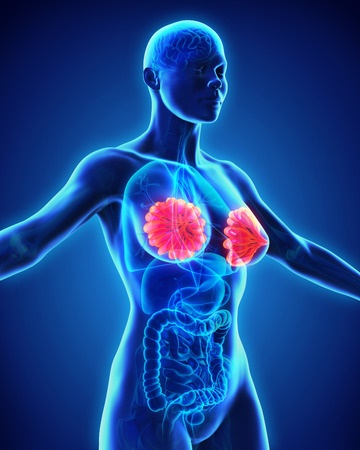
Non-cancerous, or benign, breast conditions are often seen in women. Breasts come in many different shapes and sizes and are made up of a combination of fatty tissue, glandular tissue and connective tissue. Benign breast conditions can develop in any area of the breast, producing symptoms that may be mistaken for breast cancer.
Fluctuating hormone levels can cause breasts to become sensitive or painful. These changes are often associated with a woman’s menstrual cycle, pregnancy, breastfeeding or menopause. Certain medications, such as hormone therapy and birth control pills can also trigger breast changes.
There are dozens of non-cancerous breast conditions experienced by women; some require treatment while others do not. Your OBGYN may recommend mammography, ultrasound or magnetic resonance imaging (MRI) to diagnose a suspicious area or lump. If breast cancer cannot be ruled out with these non-invasive tests, breast biopsy may be done.
One common non-cancerous breast condition, fibrocystic breasts, is characterized by lumpy, tender breasts. These lumps can increase and decrease in size throughout the menstrual cycle. To relieve pain and swelling due to fibrocystic changes, apply heat or ice packs to breasts or take an over-the-counter non-steroidal medication, such as ibuprofen.
Breast cysts are also common, particularly in premenopausal women. Some cysts may be too small to feel, while others can grow quite large. Cysts may feel soft and squishy or firm to the touch. Not all breast cysts require medical treatment. However, your gynecologist may treat large, painful breast cysts that don’t go away with fine-needle aspiration or surgery. Birth control pills may be prescribed to prevent cysts from recurring.
Fibroadenomas are non-cancerous breast lumps that are most commonly seen in women, aged 35 and younger. The solid tumors are not painful and don’t usually require treatment. Large or worrisome lumps may be removed surgically through a procedure known as a lumpectomy.
Mastitis is an inflammation or infection of the breast. The condition is seen most often in nursing mothers and is usually due to a clogged duct. In addition to breast pain and tenderness, red streaks may appear and breasts may become swollen or hot. Systemic symptoms such as fever, aches and fatigue may also be present.
These are just a few examples of non-cancerous breast conditions. If you notice changes in your breasts, the best thing to do is to schedule an appointment with your gynecologist. A clinical breast examination will help determine if further steps are necessary.





